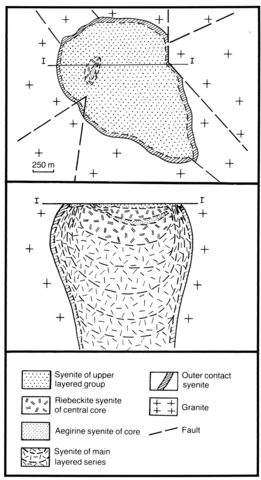stripes
The Yastrebets massif is located in the northwest of the Ukrainian shield, a short distance northwest from the Korosten anorthosite-rapakivi granite pluton. The massif is confined structurally to the Sushano-Pershansk tectonic zone, where the Yastrebets, Pershansk and Plotnitsky faults intersect. The massif is nearly oval in shape, its area being about 4 km2. It is considered to be a layered intrusion supposedly having the form of a lopolith (but see section - Fig. 42). By analogy with other intrusions, the syenites have been divided into outer contact syenites, syenites of the main layered series, quartz syenites of the central core and syenites of the upper laminated group. The outer zone of the outer contact part of the massif consists of varieties of fine-grained syenite, which are a chilled facies, the thickness of which approaches 50-70 m. Towards the centre of the massif the grain size of the syenites increases. Syenites of the layered series and the central core are usually medium-grained, but in the main layered series coarse-grained and pegmatitic syenites are also encountered. Syenites of the main layered series are more than 1000 m thick, the upper laminated group 100-200 m, while the quartz syenites of the central core are 350-450 m in thickness. The syenites are essentially of mesoperthite: plagioclase is confined to the outer contact syenites, but only forms up to 5%. The dark coloured minerals in the syenites are notable for their extremely high Fe:Mg ratios (90 and more) and include hedenbergite, aegirine-hedenbergite, aegirine, ferrohastingsite, ferroedenite, taramite, riebeckite and annite. Andradite is encountered occasionally. Accessory minerals include zircon, fluorite, orthite, ilmenite, bastna"site, parisite, britholite and, in the outer contact facies only, apatite. Rhythmic and cryptic layering occur throughout the intrusion. Rhythmic layering manifests itself in the alternation of leucocratic and mesocratic syenites, while melanocratic varieties or extremely melanocratic schlieren-like segregations composed only of dark-coloured minerals (clinopyroxene, amphibole, biotite), occur more rarely. Cryptic layering is expressed in the change in chemical composition of the rock-forming minerals towards the central core of the massif, that is in an upward direction in the main laminated group. In the same direction there is an increase in the alkalinity of the pyroxenes and amphiboles, from ferrohastingsite to riebeckite, the silica content of the biotite decreases, and the proportion of orthoclase component in the alkali feldspar increases. The same trend is also reflected by some of the accessories, for example, orthite disappears but britholite appears in the sequence. From the outer contacts towards the centre of the intrusion trends occur involving both changes in the chemical composition of the rock-forming minerals and in their paragenesis. Thus, small amounts of apatite and plagioclase (oligoclase) are encountered only in the outer contact syenites, which also show an elevated content of accessory ilmenite and orthite. However, alkaline varieties of the dark-coloured minerals are not observed in the outer contact syenites the pyroxene being hedenbergite and amphibole ferrohastingsite.
KRIVDIK, S.G. and TKACHUK, V.I. 1986. Formational classification of the alkaline rocks of the Ukrainian shield. Tezisy Dokladov VII Vesesoyuznogo Petrograficheskogo Obshchestva. Novosibirsk, 85-7.
TKACHUK, L.G. 1987. Genesis of the Yastrebets syenite massif. Geologicheskii Zhurnal, 47: 106-11.

